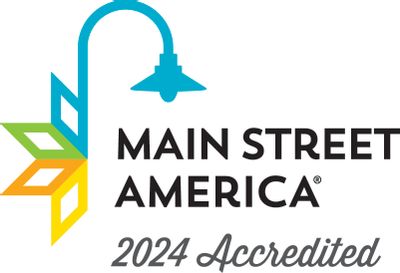
Downtowns are irrefutable contributors to, or detractors from, a city’s “quality of life”. As a city symbol, as a working and living place, as a cultural amenity, downtowns continue to embody the community’s sense of itself. That’s why communities all across the country are preserving, restoring, and celebrating their downtowns.
The Main Street program is a national initiative aimed at revitalizing downtown areas as thriving marketplaces and centers of community activity. Its success lies in its holistic approach, which focuses on enhancing the downtown's overall image. The program follows an incremental process, utilizing four key elements to achieve sustainable revitalization:
The Main Street Four-Point Approach is a distinctive, preservation-focused economic development strategy that helps communities revitalize their downtown and neighborhood business districts by harnessing local assets—such as historical, cultural, and architectural resources, along with local businesses and community pride. This comprehensive method addresses the diverse challenges faced by traditional commercial districts. Since its inception in 1980, Main Street has guided over 2,000 programs and leaders in revitalizing the spaces and businesses that contribute to vibrant, sustainable communities. With the support of the National Main Street Center and state-level downtown revitalization programs, this approach has been successfully implemented in more than 1,200 cities and towns across 40 states.
The effectiveness of the Main Street approach lies in its comprehensive design. By seamlessly integrating the four points into a practical downtown management strategy, local Main Street programs can drive significant changes in the economic foundation of their communities.
The organization focuses on creating a robust Main Street framework that includes diverse representation from business and property owners, bankers, citizens, historic preservationists, entrepreneurs, public officials, the chamber of commerce, and other local economic development organizations. Collaboration among these stakeholders is essential to rejuvenate downtown effectively. A strong organizational foundation ensures the structure and stability needed to sustain long-term revitalization efforts.
Promotion brings energy and vibrancy to downtown by organizing events such as street festivals, parades, retail promotions, and image development campaigns. These activities help showcase what downtown has to offer and drive customer traffic. Promotion focuses on marketing an appealing image of downtown to shoppers, investors, and visitors, fostering a dynamic and engaging community atmosphere.
Design focuses on enhancing the visual and physical appeal of the Downtown Historic District. Efforts such as building rehabilitation, street and alley clean-up, landscaping, street furniture, signage, visual merchandising, and lighting contribute to creating an inviting environment. These improvements not only elevate the downtown's image as a desirable place to shop, work, walk, invest, and live but also encourage the reinvestment of both public and private funds into the area.
Economic Vitality involves analyzing current market trends to develop sustainable, long-term solutions for the downtown area. This includes recruiting new businesses, creatively repurposing unused spaces, and enhancing the competitiveness of Main Street merchants. These activities are vital for fostering a resilient and thriving local economy.